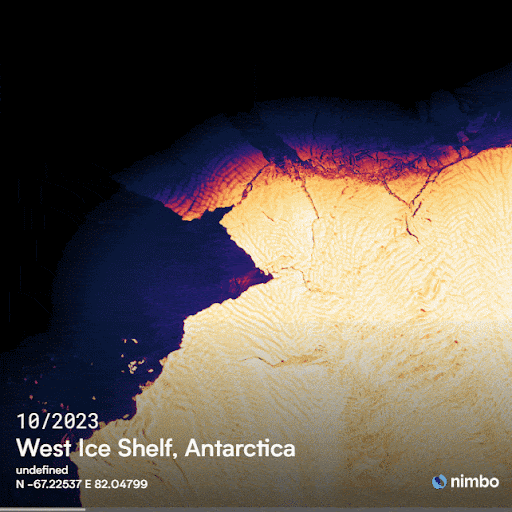
Antarctica Ice Shelf melting
Radar Satellite timelapse of West Ice Shelf’s melting
Our satellite radar image timelapse shows a part of the West Ice sheet leaving the Antarctic continent, pushing us once again to think about the phenomenon of melting ice.
We are looking at a 200 sq. km portion detaching from the 16,370 sq.km ice platform, which equals to Hawaii or Connecticut. Discovered in 1901, the West Ice Shelf has nothing western: it is, in fact, located in the eastern part of Antarctica. Dr. Erich von Drygalski and Gauss’s crew decided to name it that way during the First German Antarctica Expedition, when their boat was trapped in the ice and the “West” needle of their compass was facing the giant platform of ice.
The eastern part of Antarctica is not the most endangered and is undergoing few changes, unlike the western part of the continent. The Doomsday Glacier, located in the real West Antarctica Ice Shelt, is one of the largest glaciers in the world with 192,000 sq.km and its melting would cause a rise in water levels of more than 60cm.
The process of detachment of an Ice Shelf
The main cause of the detachment of an ice shelf comes from global warming. Glaciers are, most of the time, in contact with the seafloor, which is what keeps them stable. The flow of glaciers into the ocean creates ice shelves which are attached to the continent but float on the water.
However, with the waters of the Southern Ocean becoming increasingly warmer, the ice shelves are melting from below, the ice layer is thinning, becoming unstable and therefore losing its hold.
Antarctica melting’ consequences
Ice helps regulate the climate: its albedo effect tends to reflect and return, almost in its entirety, the light and heat received by the sun.
The melting of ice and the detachment of glacial sheets cause an increase in sea level, currently at a pace of + 3.5 mm. Cities like Jakarta or Bangkok, or islands like The Maldives could find themselves partially or even entirely underwater by 2100…
It is also putting Antarctic biodiversity at risk; the emperor penguin colony located on the shelf will have to migrate and adapt to a new environment. These phenomena also lead to a deregulation of ocean currents and water temperature, which will have serious consequences for certain marine species which risk extinction.
Finally, Antarctica also accounts for more than two-thirds of the world’s fresh water reserves, but as ice melts, fresh water is mixing with salty ocean water, reducing our resources.
Nimbo Earth Online with modified Copernicus Sentinel data (2023-2024)
